
Sphaeralcea is a genus of flowering plants in the mallow family (Malvaceae). There are about 40-60 species, including annuals, perennials, and shrubs. Most originate in the drier regions of North America, with some known from South America. They are commonly known as globemallows, globe mallows, false mallows or falsemallows. The name of the genus is derived from the Greek words σφαῖρα (sphaira), meaning "sphere," and αλκεα (alkea), meaning "mallow."

Stellaria graminea is a species of flowering plant in the family Caryophyllaceae known by the common names common starwort, grass-leaved stitchwort, lesser stitchwort and grass-like starwort.

Ceanothus velutinus, with the common names snowbrush ceanothus, red root, tobacco brush, and sticky laurel, is a species of shrub in the family Rhamnaceae. It is native to western North America from British Columbia to California to Colorado.
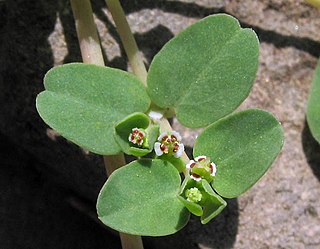
Euphorbia serpens is a species of Euphorbia known by the common name matted sandmat. It is native to South America but it can be found on most continents as an introduced species and often a weed. This is an annual herb forming a mat of prostrate stems which root at nodes where the stem comes in contact with the ground. The oval leaves occur in oppositely arranged pairs, each leaf less than a centimeter long. The inflorescence is a cyathium with scalloped white petal-like appendages surrounding the actual flowers. A red nectar gland is at the base of each appendage, and at the center of the cyathium are several male flowers around one female flower. The fruit is a lobed, spherical capsule.

Sphaeralcea gierischii, Gierisch's globemallow or Gierisch mallow, is an endangered species of flowering plant in the mallow family, Malvaceae. It is native to the western United States, where it is known only from Utah and Arizona. It was described in 2002.
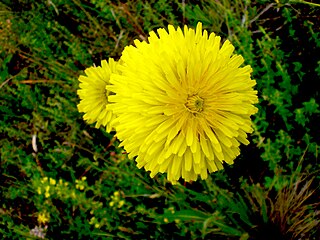
Microseris laciniata is a species of flowering plant in the family Asteraceae known by the common name cutleaf silverpuffs. It is native to the western United States from Washington to northern California and Nevada, where it grows in forest and grassland habitat.

Orobanche fasciculata is a species of broomrape known by the common name clustered broomrape. It is native to much of western and central North America from Alaska to northern Mexico to the Great Lakes region, where it grows in many types of habitat. It is a parasite growing attached to the roots of other plants, usually members of the Asteraceae such as Artemisia; and other genera such as Eriodictyon and Eriogonum. This plant produces one or more stems from a bulbous root, growing erect to a maximum of about 20 centimeters in height. The stems, leaves and five-lobed flowers are covered by sticky hairs. As a parasite taking its nutrients from a host plant, it lacks chlorophyll as well as a water-storage system. It is variable in color, often yellowish or purple. The inflorescence is a raceme of up to 20 flowers, each on a pedicel up to 15 centimetres long. Each flower has a calyx of hairy triangular sepals and a tubular corolla 1.5–3 cm long. The flower is yellowish or purplish in color.
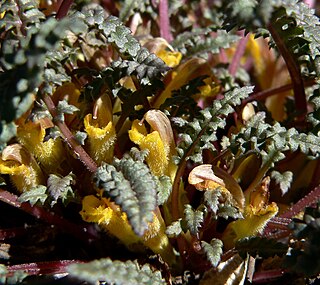
Pedicularis semibarbata, known by the common name pinewoods lousewort, is a species of flowering plant in the family Orobanchaceae.

Proboscidea althaeifolia is a species of flowering plant in the family Martyniaceae known by the common names desert unicorn-plant and yellow-flowered devil's claw. It is native to the desert southwest of the United States, where it grows in sandy habitat and blooms during the hot summer. This is a perennial herb growing from a thick, tuberlike yellow root. The stem is decumbent, creeping along the ground. The shiny leaves have rounded, oval, or roughly triangular blades up to 7 centimeters long which are deeply lobed and wavy along the edges. The inflorescence is an array of many showy, fragrant, bell-shaped flowers with five lobes flaring several centimeters wide. The flower is yellow to orange or apricot with an intricate pattern of speckles and streaks, its lower lobe lined with a nectar guide. The fruit is a large seed pod many centimeters long, a cylindrical body tapering into a very long, thin, curving tail. As the fruit dries the tail cracks open and splits into two hooked, claw-like halves. These hard, dry fruits were used as tools by local Native Americans.
Senecio clarkianus is a species of flowering plant in the aster family known by the common name Clark's ragwort. It is endemic to the Sierra Nevada of California, where it grows in the moist meadows on the western slopes of the range. It is a perennial herb growing up to 1.2 meters tall from a caudex and fibrous root system. The solitary erect stem is lined evenly with leaves up to about 18 centimeters long, their blades deeply lobed or dissected into narrow, pointed segments. The herbage is hairy to woolly in texture. The inflorescence bears several flower heads which are lined with green-tipped phyllaries. They contain many yellow disc florets and each has usually 8 or 13 narrow yellow ray florets about a centimeter long, sometimes longer.
Solanum dimidiatum is a species of plant in the family Solanaceae known by the common names western horsenettle, Torrey's nightshade, and robust horsenettle. It is native to the central United States, where it grows in many types of habitat, including disturbed areas. In California it is known as an introduced species and a noxious weed. It is a rhizomatous perennial herb producing an erect stem up to 80 centimeters tall. It is covered in yellow prickles and branched hairs. The leaves may be up to 15 centimeters long, their edges wavy to lobed and sometimes toothed. The inflorescence is a branching array of several flowers. Each flower has a bell-shaped corolla measuring 3 to 5 centimeters wide. It is lavender to purple, or white. The five large, yellow anthers are about a centimeter long. The fruit is a spherical yellow berry up to 3 centimeters wide.
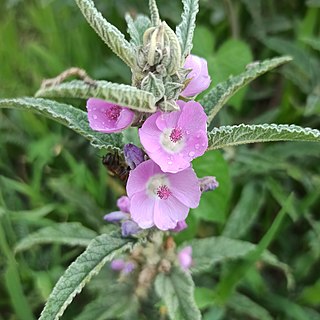
Sphaeralcea angustifolia is a species of flowering plant in the mallow family known by the common names copper globemallow and narrow-leaved globemallow. It is native to the southwestern United States as well as northern and central Mexico, where it grows in desert and plateau habitat. It produces many erect stems, approaching three meters in maximum height. It is woolly or felt-like in texture. The gray-green leaf blades are lance-shaped and measure up to about 5 cm long. They have wavy or slightly lobed edges. The leafy inflorescence bears several flowers each with five wedge-shaped orange petals just under 1 cm in length, and yellow anthers.

Sphaeralcea coulteri is a species of flowering plant in the mallow family known by the common name Coulter's globemallow. It is native to the Sonoran Desert, its distribution extending from northern Mexico north into California and Arizona. It is an annual herb, its slender, hairy stems sprawling or growing erect to a maximum height near 1.5 meters. The thin, gray-green leaf blades are wide and short, heart-shaped or triangular in shape, and measure up to about 5 centimeters long. They have a few wide lobes along the edges which may have teeth or smaller lobes. The leafy inflorescence bears clusters of flowers each with five wedge-shaped orange petals around a centimeter long, and yellow anthers.

Sphaeralcea emoryi is a species of flowering plant in the mallow family known by the common name Emory's globemallow. It is native to the Southwestern United States, California and Northwestern Mexico. It grows in desert habitat and sometimes disturbed areas such as roadsides.

Sphaeralcea munroana is a species of flowering plant in the mallow family known by the common names Munro's globemallow and Munro's desert-mallow. It is native to the western United States, where it can be found in the Great Basin and surrounding regions. It grows in sagebrush, desert flats, mountain slopes, and requires plenty of sunlight to thrive. This perennial herb produces erect stems up to about 80 centimetres (31 in) tall from a thick root system. It is woolly and gray-green in color. The alternately arranged leaves have triangular blades up to 6 cm long, usually edged with large lobes and a toothed margin. Flowers occur in clusters on a raceme-like inflorescence. The flower has five apricot to red-orange petals each just over 1 cm long.
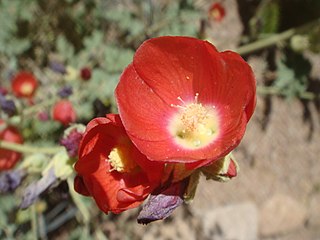
Sphaeralcea rusbyi is a species of flowering plant in the mallow family known by the common names Rusby's globemallow and Rusby's desert-mallow. It is native to the southwestern United States, where it can be found in various types of desert habitat. The species is generally divided into three subtaxa which grow in separate sections of the desert southwest. In general, the plant produces hairy or woolly stems which can reach three meters tall. The leaves are lobed or compound. The flowers each have five red-orange petals up to 2 centimeters long.

Stellaria calycantha is a species of flowering plant in the family Caryophyllaceae known by the common name northern starwort. It is native to western North America from Alaska and northwestern Canada to California and New Mexico, as well as eastern Russia. It occurs in subalpine and alpine climates, in many types of moist, shady habitats. It is a rhizomatous perennial herb producing a prostrate to erect stem up to 25 centimeters long, taking a clumpy form. The thin oval leaves have smooth edges and pointed tips, and measure up to 2.5 centimeters in length. The inflorescence bears one or more flowers, each on a long pedicel. Each flower has five pointed green sepals, and some flowers have up to five deeply lobed white petals.

Stellaria littoralis is a species of flowering plant in the family Caryophyllaceae known by the common name beach starwort. It is endemic to the San Francisco Bay Area and North Coast of California, where it grows in moist coast habitat, such as marshes, bogs, and coastal bluffs. It is a rhizomatous perennial herb producing sprawling, branching stems which are four-angled and hairy in texture, reaching up to about 60 centimeters long. The lance-shaped or pointed oval leaves are up to 4.5 centimeters long and are oppositely arranged in pairs. The inflorescence bears several flowers, each on a short pedicel. The flower has five hairy, pointed green sepals each a few millimeters long. There are five white petals, each so deeply lobed it appears to be two.
Stephanomeria parryi is a species of flowering plant in the family Asteraceae known by the common name Parry's wirelettuce. It is native to the southwestern United States, where it grows in many types of habitat, including many desert areas. It is a perennial herb growing from a thick root and producing one or more slender, upright stems up to about 40 centimeters tall. The green leaves are linear to lance-shaped with lobed edges and are up to 8 centimeters long near the base of the plant. Flower heads occur on the spreading branches. Each has up to 13 or 14 ray florets, each with an elongated tube and a whitish ligule up to 1.5 centimeters long. The fruit is an achene tipped with a spreading cluster of long, tan, plumelike pappus bristles.

Stillingia spinulosa is a species of flowering plant in the euphorb family known by the common name annual toothleaf. It is native to the Southwestern United States where it occurs in the creosote scrub of the deserts. It is an annual or perennial herb producing a clump of thick, leafy stems approaching a meter in maximum height. The alternately arranged leaves have shiny pointed oval blades 2 to 4 centimeters long and up to 1.2 centimeters wide which are lined with sharp teeth. The inflorescence is a stout spike of flowers 1 to 2 centimeters long. The plant is monoecious, and each spike has several male flowers at the tip and 1 or 2 fruit-bearing female flowers below these. Neither type of flower has petals. The ovary of the female flower develops into a three-lobed greenish capsule about half a centimeter wide. There is a tiny rough-surfaced seed in each of the three chambers of the fruit.

















